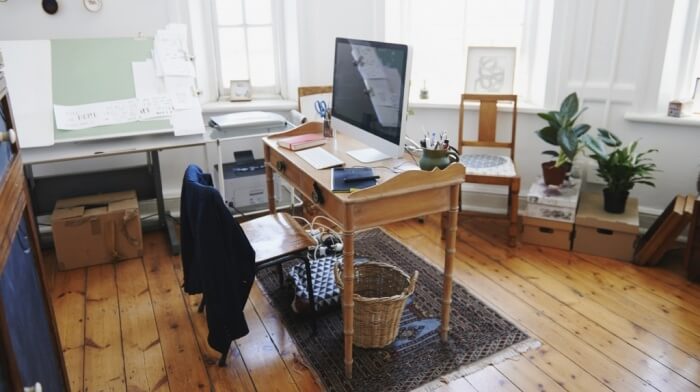A growing army of people are opting to shun the commute and work at home, here's how to create a perfect home office.
Customising The Ideal Home Office
A growing army of people are opting to shun the commute and work at home, here's how to create a perfect home office.

Home offices are increasingly becoming a big part of people’s lives. Nine-to-five office days are slowly disappearing, as more workplaces offer a more flexible working style that provides a better work-life balance and eases some of the pressure on employees.
Some reports even suggest that by 2020, half of the UK workforce will be working remotely.
Technological advances have made this transition possible. People are able to communicate and work as part of a team from opposite sides of the world thanks to video conferencing, cloud collaboration and file-sharing software, and a plethora of other online communication tools.
For businesses, this saves travelling time and costs, decreases the need for face-to-face meetings and even has them questioning the need for their office spaces. Businesses have also been getting involved in the ever increasing popularity of co-working spaces or simply allowing employees to work from home several days a week.
There is no doubt that, as we move forward, this flexibility will continue to rise and working from home will become the preferable and dominant option. But while this can be somewhat easily adopted by businesses today, productivity levels are a variable dependent on the individual.
To make this arrangement work, employees need to be able to access the same things at home as they would have in the office: the same technological requirements, the same organisation and, most importantly, the same or higher levels of productivity.
For this to be possible, the home working space has to be well constructed. Here is a guide to customising the perfect home office.
A Designated, Well-Ordered Workspace
First things first, you need the right space if you are going to work as well at home as you would do in an office setting. That means finding a separate place in the home that is shut off from the rest of the house, especially if you live with others.
A chair in your living room or a kitchen counter simply won’t cut the mustard — you need a space in your house with a desk and some private space where you can get your head down without any distractions.
Closing yourself off from activity in other parts of the house helps you psychologically prepare for a proactive day of working. You don’t need an entire office room — just a space that is not situated in the middle of activity that you can isolate yourself to without any risk of interference.
This isn’t the only benefit, however. When you live and work in the same space, it can be easy for the lines to become blurred. By having a clearly designated space, you set a clear boundary between work and play.
Keeping your home office separate means that when you’ve finished for the day, you can mentally — and physically — close the door and focus on winding down.

Adequate Natural Lighting
Continuing our theme of dedicated workspace needs, the right lighting is, of course, essential. Though people often wish for a day working from home, those who do it regularly will tell you that there are some fundamental requirements for it to be effective.
Being indoors all day, especially in an isolated environment, can have a negative effect on your mood. Access to natural light is, therefore, crucial. Natural light, whatever the weather outside, keeps your spirits up, makes you feel connected to the outside world and ultimately boosts both your mood and productivity.
You might think sitting close to a window is a recipe for distraction, but it actually significantly increases your alertness. The natural daylight shining in makes your mind more awake and, when the weather allows, a slightly ajar window can provide a physical and metaphorical “breath of fresh air.”
The All-Important Desk-Chair Combination
The most important aspects of a home office are those two components that make your space a home office — the desk and chair. Whether you are in an office, at home or working from from an Airbnb in an exotic country, comfort is a priority when you are rooted to a spot for many hours of the day.
It is essential that you have a desk with adequate space and the correct measurements, and a comfortable office chair that supports your back and posture.
Do not underestimate how important a chair can be in providing comfort, boosting productivity and, most importantly, reducing aches and pains. If you don’t have the space, time or money to invest in an effective ergonomic chair, a lumbar support pillow is a quick fix that can help to improve comfort and posture when you’re seated for hours on end.

Cabinets, Shelves and Optimum Organisation
Having discussed the foundations of the home office, it’s time to hone in and think about customising the home office desk itself. It’s important to make sure your desk and its surroundings are tailored to your needs to allow you to keep on top of all the work that you have to get through.
Clutter and disorganisation around you will mentally affect your personal organisation and sense of control over your workload.
Keeping positive and productive is all about making sure your surroundings work with — not against — you. It takes some trial and error to find the optimum organisation of your home office, but there are solutions you can implement to assist you while you determine your ideal work environment.
Help organise the mess of information and tasks in your head with some quality stationery supplies. A paper tray on the desk, a conveniently-placed file cabinet to the side of the desk and, if possible, shelving above or to the side of the desk all give you ample space to keep items organised.
A bundle of paper and tasks with nowhere to be efficiently filed is where clutter and chaos begin to multiply.
Inject Colour and Life with Plants and Decorations
A practical desk layout is extremely important, but equally so is staying upbeat and focused. Once you’ve customised your home office and have everything in its place, it’s time to add the finishing touches that make your home office a pleasant place to work.
Plants are a fantastic addition to any workspace, whether it’s a large elaborate display in the corner of your room or a small bonsai tree on a cabinet. Not only do plants and greenery liven up a workspace, but they also reduce stress, increase productivity and act as natural air filters that purify the air.
A positive, stimulating office atmosphere should be boosted with houseplants, colour and art.
Pieces of art using uplifting bright colours can be effective, but use them moderately — too much colour and busyness can be overwhelming and distracting, which won’t help when your aim is to create a space where you can knuckle down and get work done.

Stephen Flower works for Ashford Kitchens & Interiors, a quality provider of bespoke home offices, luxury kitchens, and customised bedrooms. They have been redesigning and renovating homes in and around London for over thirty years.
Thanks for signing up to Minutehack alerts.
Brilliant editorials heading your way soon.
Okay, Thanks!

